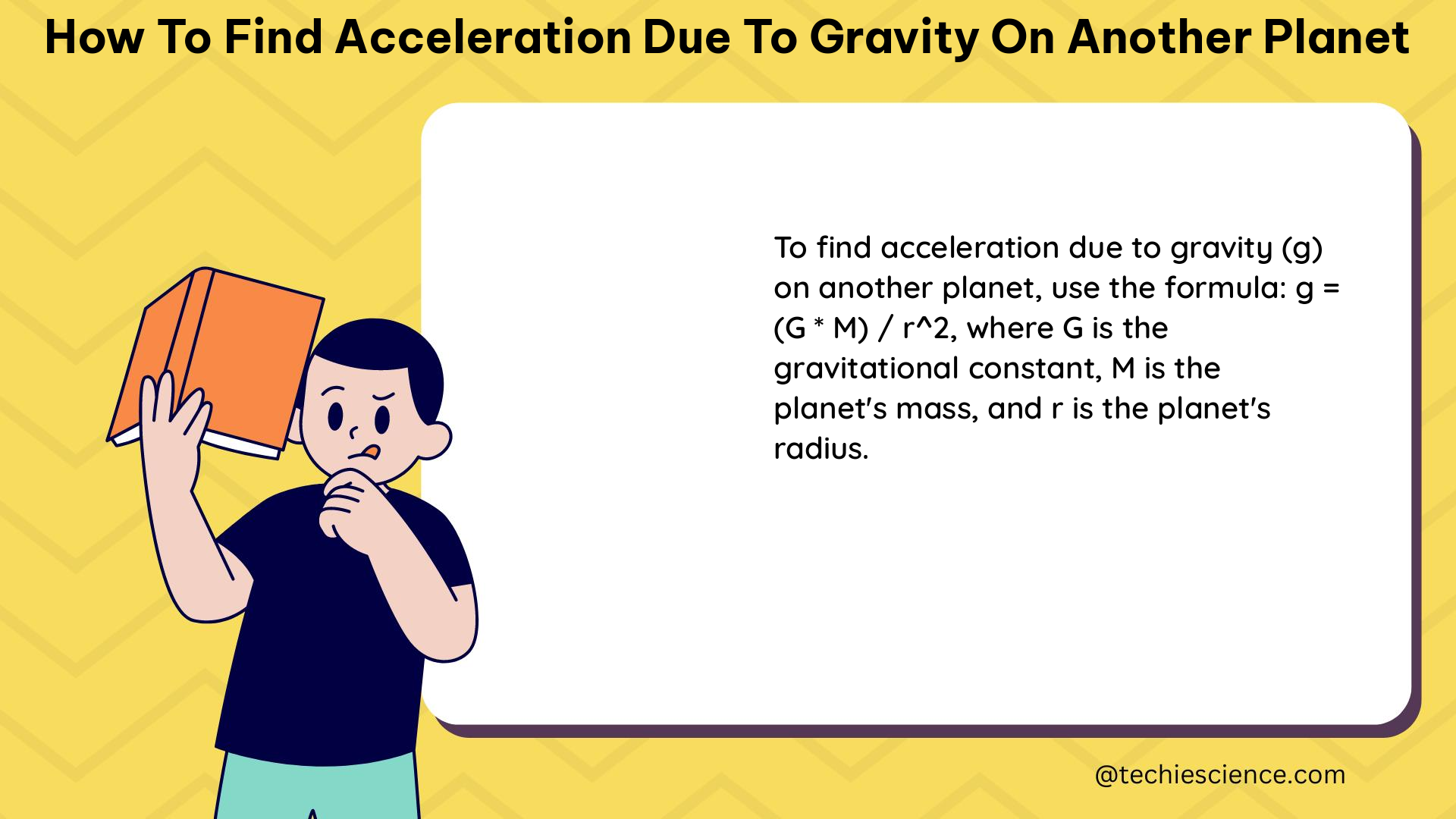Summary
To find the acceleration due to gravity on another planet, you need to use the formula g = G * M / R^2, where g is the acceleration due to gravity, G is the gravitational constant, M is the mass of the planet, and R is the radius of the planet. This article provides a detailed, technical guide on how to calculate the acceleration due to gravity on another planet, including specific formulas, examples, and numerical problems to help you master this concept.
Understanding the Gravitational Acceleration Formula

The formula to calculate the acceleration due to gravity on another planet is:
g = G * M / R^2
Where:
– g is the acceleration due to gravity (in m/s^2)
– G is the gravitational constant (6.674 × 10^-11 N⋅m^2/kg^2)
– M is the mass of the planet (in kg)
– R is the radius of the planet (in m)
This formula is based on Newton’s law of universal gravitation, which states that the gravitational force between two objects is directly proportional to their masses and inversely proportional to the square of the distance between them.
To use this formula, you need to know the mass and radius of the planet you’re interested in. Let’s go through an example calculation for the planet Mars.
Example: Calculating Gravity on Mars
To find the acceleration due to gravity on Mars, we’ll use the following values:
- Mass of Mars (M): 6.4171 × 10^23 kg
- Radius of Mars (R): 3,389,500 m (converted from 3,389.5 km)
Plugging these values into the formula:
g = G * M / R^2
g = (6.674 × 10^-11 N⋅m^2/kg^2) * (6.4171 × 10^23 kg) / (3,389,500 m)^2
g = 3.71 m/s^2
So the acceleration due to gravity on Mars is approximately 3.71 m/s^2.
Calculating Gravity Using Centripetal Acceleration
If you’re unable to directly measure the mass and radius of a planet, you can use the centripetal acceleration relationship to estimate the acceleration due to gravity:
a = v^2 / r
Where:
– a is the acceleration due to gravity (in m/s^2)
– v is the orbiting velocity of a satellite (in m/s)
– r is the orbiting radius of the satellite (in m)
For example, if a satellite orbits Mars at a velocity of 3.5 km/s (3,500 m/s) and has an orbiting radius of 17,000 km (17,000,000 m), you can calculate the acceleration due to gravity as:
g = v^2 / r
g = (3,500 m/s)^2 / (17,000,000 m)
g = 0.0725 m/s^2
However, this method assumes that the satellite is in a circular orbit, which may not always be the case.
Calculating Gravity for Gas Giants
To calculate the gravity of a gas giant (like Jupiter or Saturn) at a specific depth within the planet’s atmosphere, you need to consider the mass distribution inside the planet.
The formula for gravitational acceleration inside a gas giant is:
g(r) = (G * M(r)) / r^2
Where:
– g(r) is the acceleration due to gravity at a distance r from the center of the planet
– M(r) is the mass of the planet enclosed within a sphere of radius r
To use this formula, you need to know the mass distribution within the planet, which can be complex to determine. This is because the density of the planet’s atmosphere and interior can vary significantly with depth.
One approach is to use a model of the planet’s internal structure, such as the polytropic model, to estimate the mass distribution. This allows you to calculate the gravitational acceleration at different depths within the planet’s atmosphere.
Numerical Problems
- Calculate the acceleration due to gravity on the surface of Venus, given the following information:
- Mass of Venus: 4.8675 × 10^24 kg
-
Radius of Venus: 6,051,800 m
-
A satellite orbits Jupiter at a velocity of 47,000 m/s and a radius of 1,070,000 km. Calculate the acceleration due to gravity experienced by the satellite.
-
Estimate the acceleration due to gravity at a depth of 1,000 km inside the atmosphere of Jupiter, given the following information:
- Mass of Jupiter: 1.898 × 10^27 kg
- Radius of Jupiter: 69,911 km
Conclusion
In this article, we’ve explored the various methods and formulas for calculating the acceleration due to gravity on another planet. By understanding the gravitational acceleration formula, the centripetal acceleration relationship, and the considerations for gas giants, you can now confidently determine the gravitational acceleration on any planet or celestial body. Remember to always double-check your calculations and consider the limitations of the methods used.
References
- Socratic. (n.d.). How is the acceleration of gravity calculated for planets? Retrieved from https://socratic.org/questions/how-is-the-acceleration-of-gravity-calculated-for-planets
- YouTube. (2018). How to Calculate Gravity on Other Planets. Retrieved from https://www.youtube.com/watch?v=92VGeHBU9uo
- Reddit. (2022). How would one calculate the gravity of a planet? Retrieved from https://www.reddit.com/r/askscience/comments/z53aqr/how_would_one_calculate_the_gravity_of_a_planet/
- Study.com. (n.d.). How to Calculate the Acceleration Due to Gravity on a Different Planet: Explanation. Retrieved from https://study.com/skill/learn/how-to-calculate-the-acceleration-due-to-gravity-on-a-different-planet-explanation.html
- The Physics Classroom. (n.d.). The Value of g. Retrieved from https://www.physicsclassroom.com/class/circles/Lesson-3/The-Value-of-g

The lambdageeks.com Core SME Team is a group of experienced subject matter experts from diverse scientific and technical fields including Physics, Chemistry, Technology,Electronics & Electrical Engineering, Automotive, Mechanical Engineering. Our team collaborates to create high-quality, well-researched articles on a wide range of science and technology topics for the lambdageeks.com website.
All Our Senior SME are having more than 7 Years of experience in the respective fields . They are either Working Industry Professionals or assocaited With different Universities. Refer Our Authors Page to get to know About our Core SMEs.